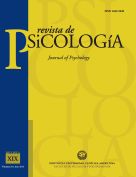El uso de detalles biográficos como información seductora en el texto de ciencias
Palabras clave:
comprensión, detalle seductor, texto expositivoResumen
Se estudió el efecto de incluir detalles biográficos seductores en un texto expositivo de ciencias. 66 estudiantes con bajo conocimiento sobre el tema leyeron el texto sin detalle seductor o con una anécdota biográfica interesante. El interés asociado a los materiales fue examinado en un estudio preliminar. Se recolectaron medidas de retención (recuerdo del texto y verificación de afirmaciones literales), comprensión (verificación de afirmaciones inferidas) y síntesis del texto (selección de un título). Los resultados indicaron que la condición que recibió el detalle biográfico tuvo más dificultades para recordar los contenidos y para contestar afirmaciones de la sección del texto próxima al detalle. Estos resultados son interpretados a la luz de la hipótesis de la integración desviada.Descargas
Citas
Britt, M. A., Perfetti, C. A., Van Dyke, J. & Gabrys, G. (2000). The Sourcer´s Apprentice: A tool for document-supported history instruction. En P. Stearns, P. Seixas & S. Weinberg (Eds.). Knowing, teaching and learning history: National and international perspectives (pp. 437-470). New York, EE.UU.: University Press.
Bruner, J. (1986). Actual Minds, Possible Worlds. Cambridge, MA, EE.UU.: Harvard University Press.
Carretero, M. & Montanero, M. (2008). Enseñanza y aprendizaje de la historia: aspectos cognitivos y culturales. Cultura y Educación, 20 (2), 133-142.
Coté, N., Goldman, S. R. & Saul, E. U. (1998). Students making sense of informational text: Relations between processing and representation. Discourse Processes, 25, 1-53.
Eason, S. H., Goldberg, L. F., Young, K. M., Geist, M. C. & Cutting, L. E. (2012). Reader-text interactions: How differential text and question types influence cognitive skills needed for reading comprehension. Journal of Educational Psychology, 3, 515–528.
Garner, R., Gillingham, M. G. & White, C. S. (1989). Effects of “seductive details” on macroprocessing and microprocessing in adults and children. Cognition and Instruction, 6, 41-57.
Goetz, E. & Sadoski, M. (1995). The perils of seduction: Distracting details or incomprehensible abstractions? Reading Research Quarterly, 30 (3), 518-519.
Harp, S. F. & Mayer, R. E. (1997). The role of interest in learning from scientific text and illustrations: On the distinction between emotional and cognitive interest. Journal of Educational Psychology, 89, 92-102.
Harp, S. F. & Mayer, R.E. (1998). How seductive details do their damage: A theory of cognitive interest in science learning. Journal of Educational Psychology, 90, 414-434.
Ivanov, I. (2010). Predictors of recall and reading time for seductive and nonseductive text segments. Tesis de Maestría no publicada, University of Nevada, EE.UU.
Kintsch, W. (1998). Comprehension: A paradigm for cognition. New York, EE.UU.: Cambridge University Press.
Le Bigot, L. & Rouet, J. F. (2007). The impact of presentation format, task assignment, and prior knowledge on students` comprehension of multiple online documents. Journal of Literacy Research, 39 (4), 445-470.
León, J. A. & Martín A. (1993). El título como recurso didáctico. Comunicación, Lenguaje y Educación, 19, 159-170.
Maturano, C., Mazitelli, C. & Macías, A. (2010). Detección de dificultades básicas de estudiantes de escuela secundaria en la comprensión de un texto de Física. Latin American Journal of Physics Education, 4, 160-167.
Mayer, R., Griffith, E., Jurkowitz, I. & Rothman, D. (2008). Increased interestingness of extraneous details in a multimedia science presentation leads to decreased learning. Journal of Experimental Psychology: Applied, 14, 329-339.
McNamara, D. (2004). Aprender del texto: Efectos de la estructura textual y las estrategias del lector. Revista Signos, 37, 19-30.
Menchen-Trevino, E. & Hargittai, E. (2011). Young adults’ credibility assessment of Wikipedia. Information, Communication and Society, 14, 24-51.
Park, B., Moreno, R., Seufert, T. & Brünken, R. (2011). Does cognitive load moderate the seductive details effect? A multimedia study. Computers in Human Behavior, 27, 5–10.
Rey, G. D. (2012). A review of research and a meta-analysis of the seductive detail effect. Educational Research Review, 7, 216-237.
Rowland-Bryant, E., Skinner, C. H., Skinner, A. L., Saudargas, R., Robinson, D. H. & Kirk, E. R. (2009). Investigating the interaction of graphic organizers and seductive details: Can a graphic organizer mitigate the seductive-details effect? Research in the Schools, 16 (2), 29-40.
Rowland-Bryant, E., Skinner, C. H., Davis- Richards, K., Saudargas, R. & Robinson, D. H. (2008). An investigation of placement and type of seductive details: The primacy effect of seductive details on text recall. Research in the Schools, 15 (2), 80-90.
Rouet, J. F., Britt, M. A., Mason, R. A. & Perfetti, C. A. (1996). Using multiple sources of evidence to reason about history. Journal of Educational Psychology, 88 (3), 478-493.
Saux, G., Burin, D., Irrazabal, N. & Molinari- Marotto, C. (2012). Inferencias causales durante la comprensión de textos expositivos en formato multimedia. Perspectivas en Psicología, 9, 160-169.
Towler, A. (2009). Effects of trainer expressiveness, seductive details, and trainee goal orientation on training outcomes. Human Resource Development Quarterly, 20, 65-84.
van den Broek, P., Virtue, S., Everson, M., Tzeng, Y. & Sung, Y. (2002). Comprehension and memory of science texts: Inferential processes and the construction of a mental representation. En J. Otero, J. A. Leon, & C. Graesser (Eds.). The psychology of science text comprehension (pp. 131-154). Nueva Jersey, EE.UU.: Lawrence Erlbaum.
Verhoeven, L. & Perfetti, C. A. (2008). Advances in text comprehension: Model, process and development. Applied Cognitive Psychology, 22, 293-301.
Vidal-Abarca, E., Reyes, H., Gilabert, R., Calpe, J., Soria, E. & Graesser, A. (2002). ETAT: Expository Text Analysis Tool. Behavior Research Methods, Instruments and Computers, 34, 93-107.
Wiley, J., Ash, I. K., Sanchez, C. A. & Jaeger, A. (2011). Clarifying readers’ goals for learning from expository science texts. En M. McCrudden, J. Magliano & G. Schraw (Eds.). Text relevance and learning from text (pp. 353-374). México: Information Age Publishing.
Descargas
Publicado
Cómo citar
Número
Sección
Licencia















